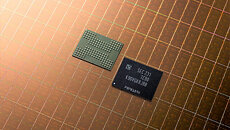TheLostSwede
News Editor
- Joined
- Nov 11, 2004
- Messages
- 18,472 (2.47/day)
- Location
- Sweden
| System Name | Overlord Mk MLI |
|---|---|
| Processor | AMD Ryzen 7 7800X3D |
| Motherboard | Gigabyte X670E Aorus Master |
| Cooling | Noctua NH-D15 SE with offsets |
| Memory | 32GB Team T-Create Expert DDR5 6000 MHz @ CL30-34-34-68 |
| Video Card(s) | Gainward GeForce RTX 4080 Phantom GS |
| Storage | 1TB Solidigm P44 Pro, 2 TB Corsair MP600 Pro, 2TB Kingston KC3000 |
| Display(s) | Acer XV272K LVbmiipruzx 4K@160Hz |
| Case | Fractal Design Torrent Compact |
| Audio Device(s) | Corsair Virtuoso SE |
| Power Supply | be quiet! Pure Power 12 M 850 W |
| Mouse | Logitech G502 Lightspeed |
| Keyboard | Corsair K70 Max |
| Software | Windows 10 Pro |
| Benchmark Scores | https://valid.x86.fr/yfsd9w |
It appears that Samsung is getting ready to beat SK Hynix in the race to 300 plus layers of NAND Flash, at least according to reports coming out of South Korea. The Seoul Economic Daily claims in an exclusive that Samsung will have a 300 plus layer V-NAND—(V for Vertical or 3D NAND—chip ready for production in 2024 and could as such beat SK Hynix by as much as a year, depending on how soon Samsung can deliver. Currently Samsung's most cutting edge stacked NAND is a 236-layer product, which is four more layers than Micron and YMTC, but two less than SK Hynix.
What sticks out in the Seoul Economic Daily news piece is that unlike SK Hynix, which is going for a triple stack sandwich, Samsung will apparently stick with two stacks. This means that Samsung is aiming for over 150-layers of NAND per stack, which seems like a big risk to take when it comes to yields. The taller the stacks, the bigger the chance of a failed stack, but maybe Samsung has found a solution around this potential issue. As modern 3D NAND relies on Through Silicon Vias, it's easier to manufacture denser stacks than in the past when wire bonding was used, but even so, this seems like a big risk for Samsung to take. That said, considering the current low demand and news of further cutbacks in production, it might be a good time for Samsung to utilise its fabs to test out this new, more densely stacked NAND to see if the company can mass produce it without issues. Samsung's roadmap calls for a 1000 plus layer V-NAND product by 2030, but it seems like the road there is still long and complicated.

View at TechPowerUp Main Site | Source
What sticks out in the Seoul Economic Daily news piece is that unlike SK Hynix, which is going for a triple stack sandwich, Samsung will apparently stick with two stacks. This means that Samsung is aiming for over 150-layers of NAND per stack, which seems like a big risk to take when it comes to yields. The taller the stacks, the bigger the chance of a failed stack, but maybe Samsung has found a solution around this potential issue. As modern 3D NAND relies on Through Silicon Vias, it's easier to manufacture denser stacks than in the past when wire bonding was used, but even so, this seems like a big risk for Samsung to take. That said, considering the current low demand and news of further cutbacks in production, it might be a good time for Samsung to utilise its fabs to test out this new, more densely stacked NAND to see if the company can mass produce it without issues. Samsung's roadmap calls for a 1000 plus layer V-NAND product by 2030, but it seems like the road there is still long and complicated.

View at TechPowerUp Main Site | Source






